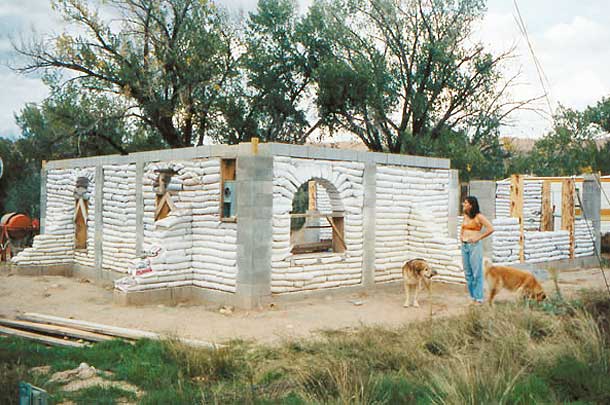Table Of Content

Create large roof overhangs of approximately 30”-36” to protect walls from moisture damage. The exact size will depend on your climate.The roundhouse has a super strong feeling due to the concrete bond beam, thick walls, sturdy poles and round shape. You could probably have a dozen workers on the roof with no visible effect. That's why I love thatch panels - they're very inexpensive and all the tedious work has already been done. And they work great on round (conical) and organic shaped roofs because they're flexible. In this method, finished floor height (F.F.) is the same height as the threshold.
Earthbag Homes: The Background
There should be no heavy lifting or backaches, no expensive equipment, and a flexible and fast construction. The bags are filled in place on the wall using small pots like coffee cans, or even kitchen utensils. Proper research before purchasing an earthbag house kit or plan is essential. The kit has a solar greenhouse, a combination of earthbags and straw bales, and a naturally-cooled pantry.
Best Locations for Earthbag Homes
One of the best benefits of constructing earthbag buildings is that you can create any structure imaginable with various shapes, sizes, and floors. The best place for constructing an earthbag house is warm, dry climates. The rule of thumb is to build a thermal mass structure for warmer temperatures and an insulated structure for cooler climates. The above earthbag house kits and plans are an excellent way to get your project off the ground. With these earthbag house plans, you’ll save time and money.
Are earthbag homes safe?
Allow adequate time for drying (about one week, depending on the temperature), and then set the door buck on the threshold and brace securely in position. Earthbags don’t require regular maintenance procedures, unlike other building materials that need painting, re-varnishing, and other maintenance work every few years. All you need to do is apply the protective plaster, which keeps water from penetrating the walls. Jaeger lives with his wife, Wren, on over 10 acres in the hills of the Ozarks.
Notes about warranties, code compliance, and engineering
There are several different techniques when it comes to constructing an earthbag home. It is important to research and get advice from earthbag house building experts who have experience building with the medium. An excellent house plan must be adequately detailed and specify the different features accurately.
Step 1: Tools and Materials
As a general rule, earthbag builders Kaki Hunter and Donald Kiffmeyer recommend stepping in a maximum of one-fourth the width of the previous bag to maintain structural integrity. In other words, a builder working with 12-inch (0.3-m) bags would step the next layer in about 3 inches (7.6 cm), so that the other 9 inches (22.9 cm) are still resting on the previous layer. Building an earthbag home is exciting, creative, and is an excellent alternative to using standard building methods.
Step 17: Conclusion
Are you interested in using cork in your next DIY project? This article lists the 12 best places to buy cork building material today and gives an overview of each supplier’s products, including what makes them unique. Adobe houses are beautiful and can blend into the landscape wonderfully.
Silt is extremely fine-grained, and using too much in an earthbag structure will weaken it. Gravel, or jagged pieces of rock, is sometimes used in earthbags, mostly at a foundational level, but builders primarily use a mix of clay and sand. Clay serves as the glue to hold sand together, while the loose, gritty particles of sand form the bulk of an earth wall's stability. Coarse, jagged sands are best because there are lots of sides for the other grains to adhere to. Earthbag builders Kaki Hunter and Donald Kiffmeyer recommend a ratio of 70 percent sand to 30 percent clay.

Because earthbag walls are usually 38 cm (15 in) thick a large amount of stabilizer is needed. Contained earth (CE) is based on the original technique, but with specific soil strengths and reinforcement chosen for hazard levels. CE uses damp, cohesive, tamped bag fill, which bonds strongly with barbed wire and other reinforcement as the wall cures. Several courses of gravel in doubled woven bags form a water-resistant foundation.

How to Build a Small Earthbag Dome A free, step-by-step description of how a 14 foot diameter earthbag dome was created. This prototype dome could serve as a model for emergency shelters, cabins, studios, garden sheds, etc. It should work well in earthquake-prone areas and places subject to flooding, winds, and hurricanes. We are interested in communication from others who are exploring the possibilities inherent with earthbag building. Use standard carpentry techniques to install doors and windows.
Filling the sandbags is the most labor-intensive and time-consuming part of the process. From excavating fill materials and putting them in buckets to filling the bags, the process requires a lot of time and labor. Before diving into the pros and cons of building an earthbag home, it’s essential to understand the basics of building one. In the rest of this article, I’ll discuss the pros and cons of building an earthbag home to help you decide whether an earthbag home is right for you.
The coils made from compressed earth within the polypropylene bags give the walls compressive strength. In southern California, the Iranian-born architect Nader Khalili developed a unique earthen architecture technique called SuperAdobe. The technique was originally designed as a prototype for NASA to create theoretical human settlements on the Moon and Mars. But, Khalili's SuperAdobe later became an affordable and practical housing alternative for refugees, people affected by natural disasters, and the homeless. After a row of bags has been laid, the tamper presses the bags down into place. This keeps the earth from shifting and keeps each layer level.
Compared to concrete, which is among the most common building materials, it’s a much more sustainable option because manufacturing a ton of cement emits about 0.9 pounds (0.41 kg) of carbon dioxide. Ease of Construction – The techniques involved in earthbag construction are not all that difficult. Even without much experience, you should be able to construct a small structure with little difficulty. You will continue as above until you reach the height of the wall desired, leaving spaces for windows and doors.
At Home: Couple builds earthbag home in rural Osage County - The Topeka Capital-Journal
At Home: Couple builds earthbag home in rural Osage County.
Posted: Thu, 29 Dec 2016 08:00:00 GMT [source]
It is able to absorb large amounts of energy and then release it slowly over time which helps to prevent quick temperature swings. The first step in building an earthbag wall is to fill a bag with dirt. You will quickly find that filling a bag on the ground without any support is possible but not easy.
There are many variables, including doors, windows, roof, and fill expenses. You can also build nooks, sitting areas, and couches out of earthbags integrated into the structure or you can inlay all sorts of shelving and storage into the walls. You can even build a fireplace into the interior, creating a seamless look and feel. If you build a dome structure, earthbags and scaffolding create the roof. This guide offers general building advice about the basic materials and processes of building an earthbag home.
However, you can construct an earthbag stand that keeps the bag open while you fill it, eliminating the need for another person. An earthbag structure’s mass will assist in keeping the interior cool in the summers. Are you looking for a DIY construction technique for building an affordable earthquake-, flood-, and bullet-resistant home?

No comments:
Post a Comment